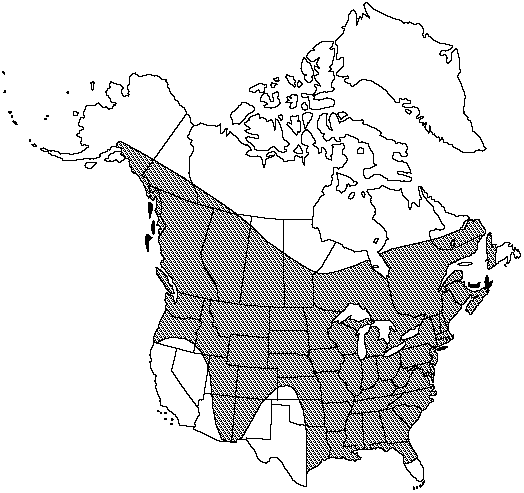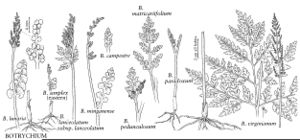Botrychium virginianum
J. Bot. (Schrader) 1800(2): 111. 1801.
Trophophore sessile; blade pale green, 3–4-pinnate, to 25 × 33 cm, thin, herbaceous. Pinnae to 12 pairs, usually approximate to overlapping, slightly ascending, distance between 1st and 2d pinnae not or slightly more than between 2d and 3d pairs, lanceolate, divided to tip. Pinnules lanceolate and deeply lobed, lobes linear, serrate, apex pointed, venation pinnate, midrib present. Sporophores 2-pinnate, 0.5–1.5 (–2) times length of trophophore. 2n =184.
Phenology: Leaves seasonal, appearing in early spring and dying in late summer.
Habitat: Common to abundant, especially in shaded forests and shrubby second growth, rare or absent in arid regions
Elevation: 0–1500 m
Distribution

Alta., B.C., Man., N.B., Nfld. and Labr. (Nfld.), N.W.T., N.S., Ont., P.E.I., Que., Sask., Yukon, Ala., Alaska, Ariz., Ark., Colo., Conn., Del., D.C., Fla., Ga., Idaho, Ill., Ind., Iowa, Kans., Ky., La., Maine, Md., Mass., Mich., Minn., Miss., Mo., Mont., Nebr., Nev., N.H., N.J., N.Mex., N.Y., N.C., N.Dak., Ohio, Okla., Oreg., Pa., R.I., S.C., S.Dak., Tenn., Tex., Utah, Vt., Va., Wash., W.Va., Wis., Wyo., Mexico, Central America, South America in Brazil, Colombia, Ecuador, Peru, Eurasia
Discussion
Botrychium virginianum is the most widespread Botrychium in North America.
Selected References
None.
Lower Taxa
No values specified.
